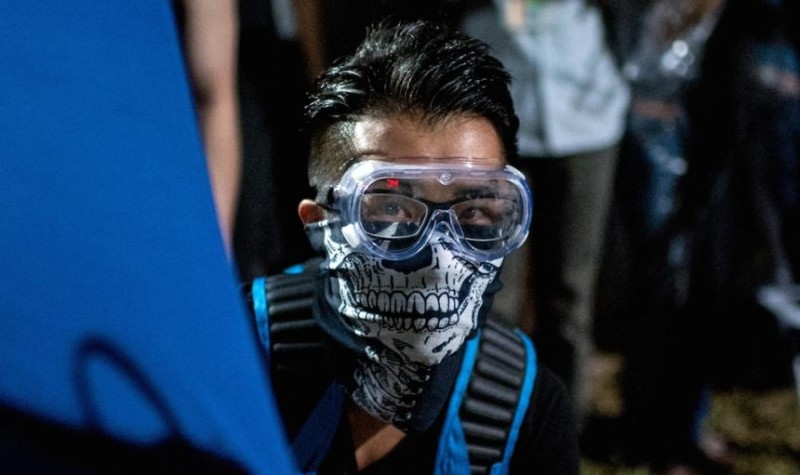Hong Kong Showdown
Pro-democracy protests enter a nasty new phase following a violent pre-dawn police raid.
By Suzanne Sataline
October 15, 2014
Foreign Policy

The city’s youth were at it again. On the night of Oct. 15, hundreds of young democracy protesters converged on Lung Wo Road near the government center, prepared for what they hoped was the next step in bringing democracy to the Chinese territory. First, they needed heavy objects.
The protest known as the Umbrella Movement — a student-led effort to ensure free and open elections for Hong Kong’s head of government in 2017 — had suffered setbacks of late. After nearly three weeks of occupying the city’s business core, the number of people taking part had shrunk. Government officials had refused to discuss changes to an elections plan that will let Beijing vet the city’s next leader, then canceled all talks with student leaders on Oct 12. On Oct. 14, it took police less than an hour to level the protesters’ dramatic barricades of bamboo, wood and concrete on Queensway, a commercial hub, returning the street to vehicles. So some of the remaining protesters decided to grab the government’s attention by taking a roadway near the government chief executive’s office.
At the eastern end of Lung Wo, a hundred or so protesters fashioned a new barricade in a manner fast becoming their signature — a matrix of steel barriers, heavy plastic gates, and wood. Then someone discovered that culverts on both sides of Lung Wo’s highway were covered with thick blocks of roughly 18 square inches — blocks that most anyone could lift. Protesters lay row after row of the slabs on the highway. Dozens of helpers, some fresh from work, knelt on the tarmac and joined the blocks with plastic ties. Sweat stained their dress shirts.
“It’s like the China Great Wall!” said Chester, a 21-year-old, slightly mangling his English. With all the photographers snapping pictures, many of the young people in the tunnel wore surgical masks and asked that their surnames be withheld to prevent future problems with police. Around the fourth row of blocks, a group of about 15 youth, dust clinging to their clothes, debated if the slabs should be set upright, or laid down. Some protesters acknowledged that they could not fend off police forever. Terence Lau, a 26-year-old assistant engineer, observed the debate. “The government,” he said, “is crazier than us.”
Around two o’clock, a cry arose from the crowd. “Police!” people shouted. The trill of whistles pierced the air. The protesters raced from the tunnel, donning safety goggles and masks. After 10 minutes, a sea of bobbing blue lights drew closer from the road’s western end. Word raced through the crowd. More police were coming from the east. And a cluster of white lights emerged from the walkway along Victoria Harbour. None had helmets — a good sign, I thought. That meant no tear gas. Hundreds of officers, with round riot shields, began pushing the crowd backwards, toward the tunnel. Another contingent pushed protesters in the other direction. Suddenly, the officers coming from the shore amassed a few feet from a group of us in Tamar Park, a small patch of lawn and trees atop the highway tunnel. The officers addressed the crowd over a bullhorn.
“They say we are here illegally,” said Lock Cheung, a freelance videographer. “Police say if they don’t leave, they will use spray.” The crowd hissed. “Gangsters!” Cheung urged us to be careful. The police, he said, “don’t follow any rules anymore.”
In minutes, police were several feet from us, yelling and shining flashlights in our faces. Along with Cheung and David Feith, a Wall Street Journal writer, I took off. The incessant, unintelligible screech of a female officer’s voice filled the air.
The line of officers ran toward us, but they were spread out along the water. Somehow, they tramped past me. I was behind the police cordon and I heard David calling to me: “Get out of there.” A male cop pushed me, and then a female officer hurled me toward some trees. I tore through bushes, past clumps of officers standing over people prone on the ground. That’s when I realized what the female voice had been saying: “This is a police line. Do not cross.”
I ran until I reached a metal barrier, the edge of a highway construction site. I turned to face the officers, holding my press badge high. I could see nothing but the flashlight beams. “Tell me where to go. I’m a reporter! I’m not crossing your fucking line.” Piercing cries distracted the cops. A few dozen feet away, a tall man was restraining a skinny young man in a teal sweatshirt and shorts, who was clearly cursing. A male officer grabbed him by the shoulder and rammed him to the ground. The officers pounced on him, binding his hands with plastic ties. I saw another set of officers sitting on top of someone else.
Running along the metal wall, I encountered a burly man with black curly hair and a beard. His face was bright red and his eyes were clamped shut. He said his name was Daniel, he was from New York, and that he’d been videotaping when a cop hit him with pepper spray. I took hold of his wire rim glasses, coated in orange goo. With two other men, we led Daniel around the fencing and police ordered us to head back toward the government complex. There the cops had pushed hundreds of protesters who were jammed between some temporary metal structures and the large network of barricades that they had created. Some young people, in their panic were climbing over the road blocks. In the mob, I let go of Daniel’s arm and lost him.
The police had stop screaming and the crowd hurried through a path and into the driveway of the office of the Chief Executive. The police had succeeded; they had pushed the protesters off Lung Wo Road and retaken the area. Soon cars and taxis buzzed past.
Stunned and exhausted, the protesters lay in heaps on the curbs and walkways. Many fell asleep. Several people mentioned seeing people kicked and beaten with fists and batons. The protesters shared their videos showing police shoving their riot shields into people’s chests. “I’ve never seen anything like this in Hong Kong,” said Adrian Gauci, who is 22. “People were just holding umbrellas and they were just hitting them.”
On Lung Wo, a new shift of police officers marched in, the boots crunching the plastic ties littering the street. “They’re like triad members,” said Cheung, the videographer I had met in the park, referring to Hong Kong criminal gangs. “We take their territory and they have to take their territory back. It’s like the 80s or 90s Hong Kong gangster movies.”
Hours later, we would all see the video: A local television crew captured police leading a man to a secluded corner where officers take turns kicking him, as another cop stands guard. A lawyer and colleagues later identified the man as Ken Tsang, a member of the pro-democracy Civic Party. In all, 45 people were arrested early Wednesday, and a team of pro-democracy lawyers told the media that five or six of those collared complained that police had punched or hit them.
Protest participants and organizers have fretted in the last two weeks that the democracy movement was fizzling, its fans fracturing without clear leadership. Some of the public, inconvenienced by blocked roads, have slammed protester actions, with some thugs attacking demonstrators sitting at major crossroads. The students pulled back from earlier demands, such as the resignation of C.Y. Leung, and focused on election rules to let the public nominate chief executive candidates — a request that Beijing has flatly rejected. Despite this, the city has been unable to end the protesters’ quixotic crusade. Sit-ins are still going on at three smaller sites.
Wednesday morning, the police action may have revived the democracy movement’s solidarity. Thousands of people came to Harcourt Road in Admiralty, and student leader Joshua Wong described the force as “thugs.” The crowd cheered.
